Russia and the U.S. keep the whole world in check, and do not allow it to develop its aviation and missile technologies
Before the end of World War II, aircraft engines were built by many different countries, and there was no monopoly on aircraft construction. But with the transition to turbojet aviation and rocket engineering, the world faced a monopoly on these technologies by only two powers – the United States and Russia. Not only could only Russians and Americans launch rockets into space, but other countries could only buy engines for serious jet aircraft from the United States and the USSR. And they themselves have not been able to fully develop anything of their own to this day.
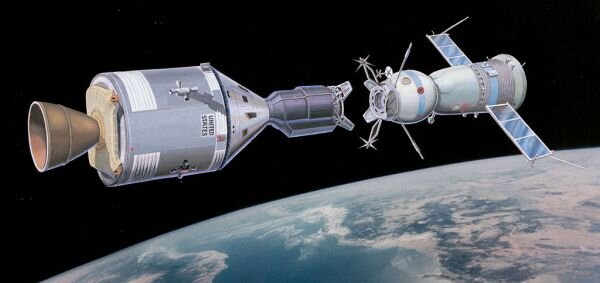
Space today is dominated by only two powers: the United States and Russia. And the Chinese space program was developed exclusively by Russia, so it serves the interests of Russia only
I have already written about the fact that all jet aviation and missile technology in the world is tied to only two countries – the United States and Russia. In this regard, I explained why China is 100% dependent on Russia for its missile and aviation technology. Well, it is clear that no Western country will give or sell to China technologies that can be used even indirectly for military purposes, and space is also, in fact, a theater of military operations.
So, why is China so dependent on Russia? And why, if the Russian leadership needs to, will all of China’s aviation and space programs come to a halt in an instant?
I will try to be more detailed, and, if possible, shorter.
No one would argue that the jet aircraft industry of any nation depends on the engine. Of course, any developed country, from Japan to Canada, can design and manufacture a beautiful aircraft, except for the United States and Russia. However, independent aircraft construction is expensive, so many countries prefer to buy aircraft from other countries, for example, Australia or Brazil.
Also, many countries can produce an aircraft engine – a piston engine, that is, with a propeller, of relatively low power. Also, many can produce a turbojet engine, but it is also low-powered, and also short-lived. The fact is that the basis of any jet engine is a turbine, which has a combustion chamber, blades, injectors, nozzles and many other elements that are exposed to high temperatures.
The technical rule states that the higher the combustion temperature of the gas in front of the turbine, the more thrust it generates and has a higher economy. But at the same time, high temperature reduces the reliability of metal elements, which are subject to powerful thermal corrosion. You can raise the temperature in the turbine to 1500 degrees Celsius, but such an engine, based on old technology, will work for a couple of minutes and fall apart.
That is why for any turbojet engine, as well as for a rocket engine, the heat resistance of the elements heated by burning fuel is very important.

German Me-262 fighter equipped with Jumo-004 turbojet engines – the world’s first engines of this type that have undergone a baptism of fire
The Germans were the pioneers in the search for heat-resistant material for jet engines. At the end of the war, they built engines for their jet fighters and missiles, but all of these engines were relatively underpowered and short-lived. The Germans lacked alloying additives that would protect the metal from corrosion. At the same time, they replaced metal with ceramic, developed a cooling system for turbine blades, and invented many other bells and whistles, but none of them were the final solution to the problem, because the problem was only exacerbated by the need to increase the power and reliability of the engines.
The same difficulties were experienced by the British and Americans, who also worked on turbojet engines. But all this research required a huge amount of money, which the British did not have, and they ceded all their developments to the Americans, however, they gave some of it to Stalin in exchange for German V-2 rockets found by Soviet intelligence officers in Poland. This is how the USSR received the British Nin and Derwent jet engines.
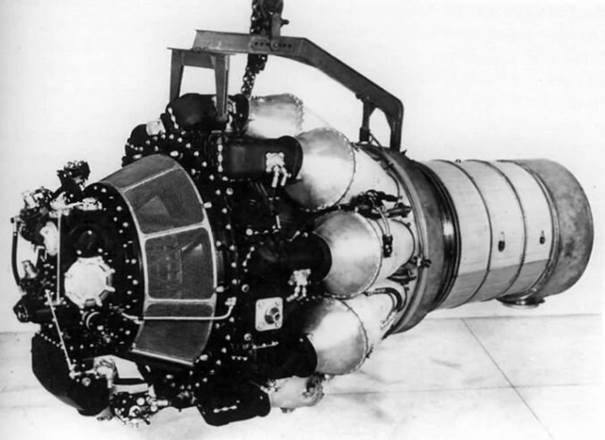
The British Nin engine, several dozen of which were sold to the USSR in 1947, and without any license. All engines had a lot of design defects, which Soviet engineers had to eliminate in order to start studying the characteristics of these engines
However, Soviet specialists were not interested in the engines themselves, but in the schemes according to which they were to be produced, which was not possible during the war. The engines themselves were weak and had a short service life, so it was necessary to apply Soviet technologies in the field of heat-resistant steels to them. This is how the first domestic turbojet engines RD-45 and VK-1 were developed, which began to be produced in many tens of thousands of pieces, and which began to be equipped with Soviet military aviation, and then the first space technology.
The British themselves did not follow the path of improvement, increasing reliability and increasing the power of jet and rocket engines – a banal lack of funds affected. In order to increase all these parameters, it was necessary to involve in this area an avalanche-like involvement of capacities that the British did not have. Moreover, the Americans were not interested in this, as they concentrated all turbojet and missile construction in their own hands. And the British were promised to share finished products on the cheap, as with their closest allies.
The Americans promised the French the same, and forbade the Germans and Japanese to develop this sphere, although they also promised a lot. In general, they acted quite logically, taking control of the entire rocket and missile sphere, so that, God forbid, it does not get out of control and does not turn into a headache for America.
Of course, the United States did not succeed in taking control of the USSR, and the Americans did not try very hard. They acted according to the principle – “Bolívar will not withstand three, but two will survive.” The Americans concluded a gentleman’s agreement with the Soviet leadership, based on common sense – not to distribute anything that could breed dangerous competitors. Not only turbojet technologies, but also nuclear technologies got here, and this treaty is still in force today.
And whoever thinks that America or Russia (formerly the USSR) gave away all these technologies to their allies would be wrong. No one gave away technology to anyone. I am referring to the technologies for creating heat-resistant alloys, which make it possible to produce good and powerful turbojet and rocket engines. Any country can design airplanes, it can even design good engines for them. But where will this country get heat-resistant blades, nozzles, injectors and other “consumer goods” used in such engines?
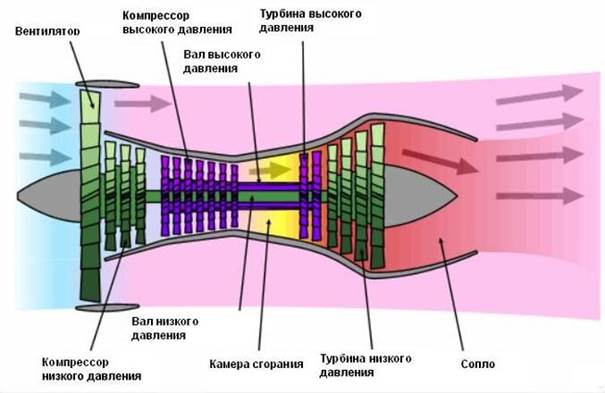
Turbojet engine in schematic section. Yellow indicates the highest temperature zone inside the engine
All this can be obtained only from two countries in the world that have technologies for the production of heat-resistant alloys. However, over the past 30 years, the United States has lagged far behind Russia in this area, and the Americans eventually had to purchase Russian RD-180 rocket engines for their space rockets.
As for other countries, neither Great Britain nor France, which have been developing turbojet and rocket engines since the end of World War II, if they have developed the field of heat-resistant alloys, then only in cooperation with the United States, and only under the control of the Americans. All European factories that produce jet engines for military and civil aviation receive all the necessary components only from America. They simply don’t have the resources to develop their own powerful and durable engines.
China is another matter. Modern China is a very rich country, and it would not be difficult for the Chinese to create their own “heat-resistant” industry. But they were never able to create a powerful and reliable engine not only for spacecraft, but also for aviation, including civil aviation. At the same time, neither America nor Russia sells them technology, and the Chinese have to use only what they can buy or sniff out.
Someone will ask, but what about the Chinese rocket engines, which are used by Chinese spacecraft to fly into space?
Well, don’t think that the Chinese developed them themselves. The Chinese have not developed anything in this area, and what their missiles fly on is a copy of the old Soviet RD-120 rocket engine, the license for the production of which they bought in the 90s from Ukraine, which produced them during the Soviet era. But the Chinese did not know how to produce heat-resistant elements for such an engine, so all this was purchased from the same Ukraine, which, out of friendship, bought all this cheaply from Russia, and then sold it to China out of the same friendship, but at a higher price.
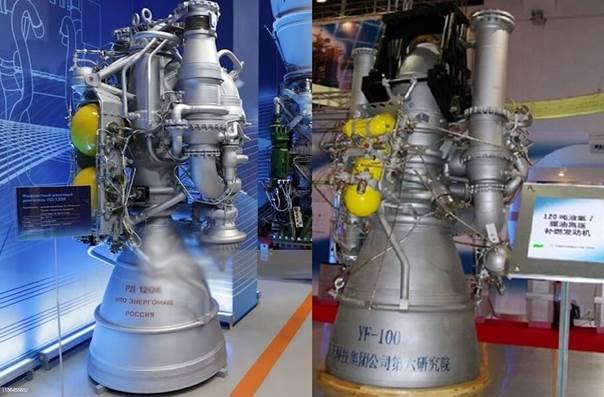
On the left is the Soviet RD-120 rocket engine, on the right is the Chinese YF-100
But in 2014, the situation changed, and the production of RD-120 in Ukraine ceased – heat-resistant elements stopped coming from Russia. The Chinese have found themselves in an unenviable position, and so now they have to buy all this in Russia, but, of course, at different prices and on different terms. And what to do? After all, it is necessary to develop space, and without an engine, not a single rocket will take off.
But the problem here is different. The RD-120 is a very low-power engine, and to implement great plans, you need engines three times more powerful. Russia has such an engine, the RD-180, the same one that the Americans still continue to buy from us. But if the Ukrainians, when supplying the RD-120, did not impose any control requirements on the Chinese, then Russia will not sell the RD-180 uncontrollably. Each taxiway will be accompanied by a whole detachment of Russian specialists, who will service these engines directly in China, and no Chinese will be allowed to see them.
Do you think the Chinese will agree or not? They cannot produce their own engines, the Americans will not sell them anything, even with full control. Who to go to, where to go?
The same is true today for Chinese turbojet engines. The Chinese can claim as much as they want that they have created some powerful and reliable aircraft engines, but they still do not have these engines and do not foresee them. And if anything is developed, it is only for heat-resistant elements, which will have to be bought from Russia, because the Americans do not want to deal with China in this area.
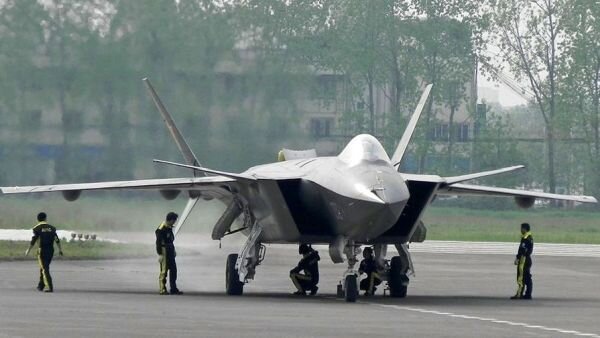
Even the latest Chinese fighters are forced to fly either on Russian engines or on Chinese consumer goods
But Russia is not very eager to develop the Chinese military industry, and this is quite logical. It is much more profitable for Russia to sell ready-made engines, rather than elements on which, of course, you can make money, but less than on the whole engine. But it’s not even about earnings, but, again, about control. If China does not agree to Russia’s control of its military aviation, then China will simply not have any aviation.
Well, where else can the Chinese get heat-resistant alloys for turbine blades, nozzles, injectors and combustion chambers? They, of course, have their own turbojet engines, but again, these are all copies of the old Soviet ones, but at the same time their resource is much (orders of magnitude) less, and reliability is questionable. The fact is that the Chinese use metals doped with low-heat-resistant components, while in Russia and America monocrystalline technology has long been used for this, that is, all heat-resistant elements, for example, turbine blades, are simply grown from a single crystal.
In this way, the granular structure of the material is avoided, and therefore the strength and resistance to very high temperatures are increased many times over. The new engines, equipped with monocrystalline heat-resistant components, have increased power and efficiency.
Do the Chinese have such technology?
Of course not. Chinese steelmakers have not yet learned how to alloy even ordinary steel properly, so they buy engines for their airliners from the Americans, and for combat aircraft from the Russians.
It is said that the Chinese have developed a lot of different technologies. Of course, I’m not going to argue, maybe they have developed some technologies. But here we need to define what technology is. Technology is what makes it possible to develop a particular area so as not to depend on other powers for its development. Perhaps, in some ways, China does not depend on other powers, but in the field of rocket engineering and turbojet aviation, it depends on its foreign friends not just strongly, but 100%.
By the way, the same applies to nuclear technology, in which China is again completely dependent on Russia.
